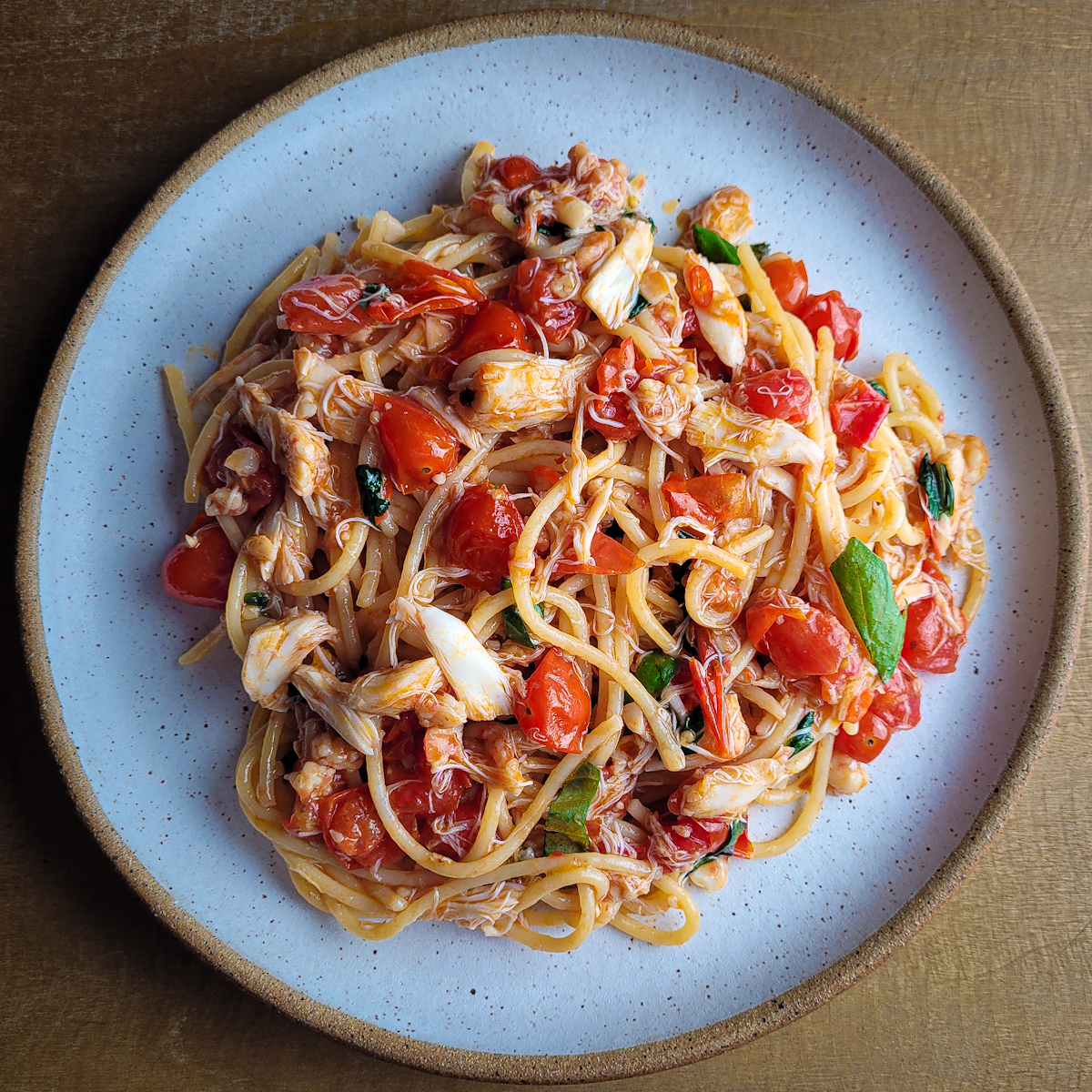Shrimp and Crabmeat Spaghetti with Cherry Tomatoes, Garlic, and Chili
5.0
(1)
Your folders
Your folders
Prep Time: 20 minutes
Cook Time: 20 minutes
Servings: 4
Author : Ian Benites

Ingredients
Export 10 ingredients for grocery delivery
Instructions
Step 1
You will need two, 6-8 quarts pots to make this pasta. One is for boiling the pasta and the other is for making the sauce and finishing the dish. Use the heavier of the two pots to make the sauce as it will reduce chance of scorching.
Step 2
If you would like, you can devein the shrimp. I usually never devein them for this dish and I have never had an issue with any off-flavors or textures.
Step 3
Chop the shrimp until you have achieved the texture of coarsely ground beef. Set shrimp aside.
Step 4
If you are using bird chilis, slice them finely into rings. Set aside
Step 5
Make sure you have all of your ingredients cut and measured before starting to cook!
Step 6
Bring about 4 quarts of water to a boil and season with salt until the water has the salinity of a well seasoned soup. Do not season it as salty as the ocean.
Step 7
While the water is coming to a boil, place 5 Tbsp of olive oil and 1 Tbsp of crushed red pepper flake in the other pot (the heavier of the two pots). Turn the heat on to medium-high.
Step 8
Carefully watch the chili flakes as the oil heats up. when the chili flakes begin to darken and you start to smell a toasty chili aroma, add the 1/2 cup sliced garlic.
Step 9
Cook the garlic over medium-high heat while stirring and when the garlic start to get brown and toasty, add the chopped shrimp.
Step 10
Break up the shrimp with a spoon and season it with a big pinch of salt as it cooks. Keep cooking and stirring until the shrimp is no longer translucent and its is all broken up.
Step 11
When the shrimp has just cooked through, add the 5 cups of halved cherry tomatoes, season them with salt, stir, and allow to cook over medium-high heat.
Step 12
After you add the tomatoes to the pot, add the spaghetti to the boiling water. Make sure you stir the pasta for the first 2 or 3 minutes to keep the pasta from clumping. Please note that you will be intentionally undercooking the pasta and finishing the cooking process in the other pot along with the sauce.
Step 13
While the pasta is boiling, keep the cherry tomato sauce simmering over medium high heat until the tomatoes start to break down and release their juices. Once you see that the tomatoes have softened and there is a good amount of tomato juice in the bottom of the pot, turn off the heat while you wait for the pasta to finish boiling, The tomatoes will take anywhere between 3-10 minutes to break down, depoending on how ripe they were.
Step 14
When the spaghetti has reached a doneness that is slightly under al dente (about 1 minute before reaching al dente), use a pair of tongs or a strainer to transfer the spagetti from the pot of water to the pot with the tomato sauce. It's OK if some of the pasta water gets transferred along with the spaghetti. (Do not discard the pasta cooking water! If you are draining the pasta using a colander, make sure to reserve at least 3 cups of the pasta water)
Step 15
After adding the pasta to the tomato sauce, add the crabmeat, 10 Tbsp olive oil, the sliced thai chili, and 1 cup of pasta water.
Step 16
Turn the heat on to high heat and use a pair of tongs to stir everything together as the sauce comes back to a simmer.
Step 17
Initially, the sauce at the bottom of the pot may appear a touch watery. Allow the sauce to cook while stirring the pasta until the sauce has thickened and achieved a slightly "creamy" apearance. The pasta should only cook for about a minute or two once the sauce comes back to a simmer.
Step 18
Adjust the consistency of the pasta by adding as much pasta water as necessary. If pasta seems dry and stodgy, do not be afraid to add up to 1-2 additional cups of pasta water so that the sauce is creamy without becoming overly watery. Stir in the basil leaves and season with additonal salt if necessary.
Step 19
If the finished dish seems a bit oily before serving, give it a good stir to try and re-emulsify the sauce. If this does not work, there is probably not enough water in the sauce to keep the olive oil emulsified. Add water, 2 tablespoons at a time while stirring, until the sauce re-emulsifies and becomes creamy. You can serve the spaghetti with a wedge of lemon, some garlicky breadcrumbs, or even some freshly microplaned pamesan cheese if you like (that whole "no cheese with seafood" thing is BS), although none of these are neceassary.